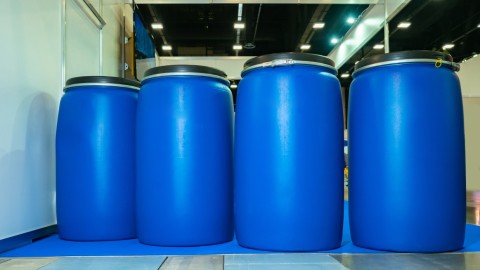Hazardous substance labeling – 9 pictograms and examples
The CLP Regulation requires all hazardous substances to be labeled with the 9 hazard pictograms from the UN’s Globally Harmonized System. In this blog article, we provide a high-level view of the hazardous substance groups, their hazard characteristics and examples.
Hazardous substance symbols and examples
The German Hazardous Substances Regulation (GefStoffV) and German Major Incident Regulation (StörfallV) inform all work involving hazardous substances. The StörfallV imposes certain conditions on large-scale users of hazardous substances. Both regulations require certain precautions to be taken to protect human health and the environment. The substances are listed and explained below.
Table of contents
- 1. Labeling for toxic substances
- 2. Labeling for substances posing serious health hazards
- 3. Labeling for explosive substances
- 4. Labeling for flammable substances
- 5. Labeling for oxidizing substances
- 6. Labeling for substances that are hazardous to the aquatic environment
- 7. Labeling for corrosive substances
- 8. Labeling for substances that are health hazards/hazardous to the ozone layer
- 9. Labeling for pressurized, dissolved or cryogenic gases
- Download hazardous substances checklist
- Key topics on hazardous substances
1. Labeling for toxic substances

(Pictogram: skull and crossbones)
Characteristics of acutely toxic substances
Even in very small quantities, these substances can cause acute damage to health and be fatal if inhaled, swallowed or absorbed through the skin.
- Examples: hydrogen fluoride, boron trifluoride, phosphorus trichloride, crotonaldehyde
Characteristics of toxic substances
Even in small quantities, these substances can cause acute damage to health and be fatal if inhaled, swallowed or absorbed through the skin.
- Examples: : ammonia, chlorine, sulfur dioxide, mercury, methanol, formaldehyde
2. Labeling for substances posing serious health hazards

(Pictogram: health hazard)
Characteristics of substances that are health hazards
Substances that pose serious health hazards can cause chronic health damage to organs, for example.
- Example: methanol damages organs (eyes)
Characteristics of carcinogenic substances
All hazardous substances that can cause cancer, alter genetic material or impair reproduction must also be marked with the “health hazard” symbol.
- Examples: dimethyl sulfate, hydrazine, benzene, formaldehyde
3. Labeling for explosive substances

(Pictogram: exploding bomb)
Characteristics of explosive substances
Explosive hazardous substances can explode by impact, friction, heating, fire or other ignition sources.
- Example: dibenzoyl peroxide
4. Labeling for flammable substances

(Pictogram: flame)
Characteristics of extremely flammable gases and liquids
Flammable substances can be ignited by an ignition source at a temperature as low as 23 °C with a boiling point not exceeding 35 °C. Since these substances are already gaseous or evaporate at low temperatures, there is a risk of explosion when mixed with air and exposed to a nearby ignition source, such as a lit cigarette.
- Examples: natural gas (methane), hydrogen, dimethyl ether
Characteristics of highly flammable liquids
This class includes all liquid substances that can be ignited by an ignition source below 23 °C and whose boiling point is above 35 °C.
- Examples: acetone, ethanol, ethyl acetate, methanol, methyl acetate, butyraldehyde
Characteristics of flammable liquids
Substances that can be ignited by an ignition source at temperatures of 23 °C and above are classified as flammable liquids. Liquids that can only be ignited at a temperature of more than 60 °C no longer belong to this group.
- Examples: n-butyl acetate, acetic anhydride
5. Labeling for oxidizing substances

(Pictogram: flame above a circle)
Characteristics of oxidizing substances
Oxidizing substances are not usually flammable on their own. However, they can considerably increase fire hazards and the severity of an existing fire when brought into contact with flammable substances.
- Examples: chlorine/ oxygen (gaseous), nitric acid/ hydrogen peroxide (liquid), sodium nitrite (solid)
6. Labeling for substances that are hazardous to the aquatic environment
Characteristics of substances hazardous to the aquatic environment
Substances are considered harmful to the environment if they or their conversion products are acutely or chronically hazardous to water. These hazardous substances must be marked with the “environmental hazard” GHS pictogram.
- Examples: diesel fuel, hydroquinone, sodium hypochlorite
- Ozone-depleting substances (CFCs), by contrast, are marked with an exclamation mark.
7. Labeling for corrosive substances

(Pictogram: corrosive)
Characteristics of corrosive substances
These hazardous substances are corrosive, i.e. they can attack and destroy surfaces or living tissue. Corrosives include acids, bases and compounds that have an alkaline or acidic reaction with water. These hazardous substances can be organic or inorganic, solid, liquid or gaseous. Corrosive gases can damage the airways and lungs even in low concentrations. Liquids are particularly dangerous if they get into eyes or onto skin and attack the tissue.
- Examples: formic acid, acetic acid, sulfuric acid, sulfur trioxide, nitric acid, hydrochloric acid, sodium hydroxide, phenol
8. Labeling for irritant substances

(Pictogram: exclamation mark)
Characteristics of irritant substances
Substances bearing this label irritate the skin and mucous membranes on single or repeated contact. This can cause inflammation of the affected areas.
- Examples: potassium carbonate, sodium carbonate, amidosulfonic acid
Characteristics of harmful substances
An exclamation mark is also used to label harmful substances that can cause acute health damage if swallowed, inhaled or absorbed through the skin.
- Examples: acetaldehyde, ethylene glycol, trioxane
9. Labeling for pressurized, dissolved or cryogenic gases

(Pictogram: gas cylinder)
Characteristics of gases under pressure
This is a new hazard class for compressed, liquefied, cryogenic or dissolved gas. The pressure must be more than 200 kPa.
- Examples: Even fire extinguishers that use carbon dioxide as a propellant are marked with this pictogram and related warnings and safety instructions.
Hazardous substances must not only be marked with GHS pictograms; they must also be listed in a hazardous substances list. To learn how to prepare a risk assessment with an exposure register, see the article “Assessing the risk of hazardous substances”.
Note: Some of the examples cited for individual classes of hazardous substances actually require multiple pictograms.




